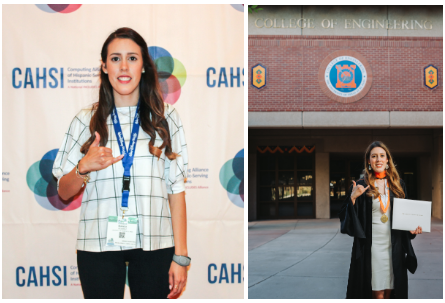The Role of Federal Agencies in Supporting Hispanic-Serving Institutions and STEM Diversity

Introduction
For years, the fields of Science, Technology, Engineering, and Mathematics (STEM) have lacked diverse representation of students. In some disciplines, like computer science, diversity has remained especially stagnant. However, there are growing initiatives to promote the success of minoritized students in STEM. The Computing Alliance of Hispanic-Serving Institutions (CAHSI) is a network of computer science departments at Hispanic Serving Institutions (HSIs) across the nation that aims to increase the number of Latinx students graduating with credentials in computer science. Bianca Alvarez, a current doctoral student in computer science at the University of Texas at El Paso, described how CAHSI has played a role in motivating her to dream beyond what she thought was possible:
“One of the things that pushed me to decide to do the masters and then go [onto] the PhD, was the workshops that I have been attending and involved [in] with CAHSI. I [didn’t] know the importance of graduate school and all of that, so I think that [participating in CAHSI] made me really make that decision. I think one important thing to mention is that having this community helped me stay in computer science and not move to another field or another career, it helped me feel that I belonged here.”

Bianca’s experience demonstrates how funding from federal agencies like the National Science Foundation (NSF) could support the existence of networks like CAHSI and promote the success of students studying at HSIs. HSIs account for 18% of all colleges and universities, and enroll approximately 66% of all Latinx undergraduate students (Excelencia, 2022). Despite limited access to funding and resources compared with more selective and typical predominantly white institutions, HSIs are often tasked with increasing the number of Latinx and other students from other minoritized backgrounds that graduate with degrees in STEM. Given HSIs’ limited access to funds, support from and partnerships with federal agencies are critical in sustaining and expanding STEM diversity efforts at these institutions.
A Brief Background on Hispanic-Serving Institutions (HSIs), Federal Policies, and Funding
Federal policies have been critical in shaping the designation of higher education institutions like HSIs. In the 1980’s, university leaders in Texas and New Mexico noticed that a growing number of Latinx college students were concentrated in a small number of institutions. Testimonies at a series of Congressional hearings in 1983 centered on two major themes facing the Latinx community: “(1) Latino students lacked access to higher education, and many who were enrolling were not completing degrees, (2) Latino students were concentrated at higher education institutions that received limited financial resources to improve their quality of education” (Excelencia in Education, 2006, p. 6). After years of congressional discussions, HSIs became an official designation, aimed at addressing the concerns of the Latinx community (Núñez, Hurtado & Calderón Galdeano, 2015).
When the HSI designation became law under the Higher Education Act of 1965 with revisions to Title III, the HSI designation provided federal funding and established one of the first partnerships between federal agencies and HSIs. This policy change directed the U.S. Secretary of Education to provide grants and related assistance to HSIs to improve and expand their capacity to serve Latinx and students from other minoritized populations. In 1994, the initiative with the Department of Education expanded into three discretionary grant programs to support HSIs. Out of these three programs, however, only the HSI-STEM program (HSI-STEM Title III) provides guaranteed funding, while funding for the other two programs must be appropriated by Congress every year.
Although Congress has allocated funding for HSIs for approximately 30 years since the establishment of the HSI designation, funding has incrementally become limited and increasingly competitive, with only 25% of HSIs receiving Title V funding (Núñez et al., 2015). The competition for funds is attributed to the continuously increasing number of HSIs. In 2019, the funds available for HSIs represented approximately $87 per Latinx student enrolled, compared to the $1,642 allotted per Black student at Historically Black Colleges and Universities (HBCUs). HBCUs and HSIs both fall within the category of Minority-Serving Institutions (MSIs), but HBCUs are considered historically-defined MSIs, while HSI are enrollment-defined MSIs, which result in distinct sources of funding (NASEM, 2019).
Promising Partnerships Between Federal Agencies and HSIs
Following the lead of the U.S. Department of Education, other federal agencies have begun to partner with HSIs to support access and opportunity for Latinx students. These partnerships have funded opportunities to conduct research, increase the pipeline of people from diverse backgrounds entering STEM fields, and strengthen collaborations with HSIs to diversify applicant pools within federal agencies or federally supported programs. Some of these partnerships to diversify the workforce at federal agencies have existed for decades. Federal agencies that have partnered with HSIs and MSIs include:
- US Department of Agriculture
- US Department and Housing and Urban Development,
- Department of Energy
- Department of the Interior
- US Agency for International Development
- Department of Defense
- Department of Homeland Security
- Department of Commerce
In addition to engaging in these partnerships with federal agencies, HSIs can also compete for funding from agencies like the National Science Foundation. As Bianca shared, programs at HSIs that are funded by NSF can have an influential impact on students’ career trajectories. By engaging with the Computing Alliance of Hispanic-Serving Institutions (CAHSI) network, one of NSF’s grant recipients, students could receive additional support within their HSIs to pursue a career in STEM. Legislation has also been established to support NSF in their efforts to partner with HSIs. In 2017, Congress mandated that NSF allocate funding directly to HSIs to build capacity in STEM fields (NASEM, 2019).
In 2019, HSI leaders in computing fields convened for a workshop to discuss how NSF could better support HSIs and their MSI counterparts in conducting research. This NSF workshop led to a meeting with two other MSI groups (HBCUs and Tribal College Universities), which generated recommendations for how both MSIs and NSF can take actions to build capacity in grant applications. These recommendations led to the implementation of research workshops by CAHSI. Some of these workshops included: (a) collaboration among Latinx computer scientists and those at HSIs on grant applications; (b) professional development opportunity for computer scientists at MSIs to sharpen their grant-writing skills; and (c) a specialized call by the NSF Computer and Information Science and Engineering (CISE) inviting MSIs that had never been funded by that directorate to submit proposals for funding (ASEE, 2020). The NSF CISE Directorate has now funded multiple MSIs to conduct new research in computing fields. These recent efforts show how feedback obtained from HSIs and MSIs could inform NSF’s work in creating mutually beneficial partnerships (NASEM, 2019) to more effectively address the perspectives and needs of these institutions.
Potential Policy Directions
Despite increasing attention and federal support given to HSIs and MSIs, a greater amount of federal funding is still allocated to selective higher education institutions that graduate fewer minoritized students from STEM fields (Armitage, 2018; NASEM, 2019; Taffe & Gilpin, 2021). Given the success of MSIs and HSIs in graduating students of color, there should be more programs that support the efforts of HSIs and their MSI counterparts to diversify the workforce, particularly in disciplines like STEM (NASEM, 2019). As congressional policymakers think of innovative ways to address the needs of HSIs, federal partnerships can serve as a key lever for substantial and meaningful impact, particularly in connection with important legislation like the CHIPS and Science Act of 2022. Our recommendations to strengthen such partnerships include the following:
- Federal agencies expand mutually beneficial partnerships with HSIs. Through grant-based programs, resource allocations, technical support, internship opportunities, and other forms of partnerships, HSIs and federal agencies can work together to broaden STEM opportunities for students, faculty, and members of HSIs.
- Create sustainable pathways for these new and growing partnerships. These steps towards sustainable partnerships should include increased mandatory resource allocations for HSIs that are renewed on a regular basis.
- Federal policymakers increase investments in evaluating the impact of partnerships with HSIs. These feedback mechanisms can guide continuous improvement of the partnerships and the expansion of successful practices.
- Federal policymakers solicit feedback from HSIs at an early stage to inform the development of these partnerships. These early steps to incorporate feedback could guide the formation of partnerships that will more authentically build capacity for research and student success at HSIs.
Federal partnerships with HSIs can build greater capacity at these higher education institutions and transform the students’ professional and academic opportunities. Bianca’s story is a reminder of the life-changing impact that such partnerships can have on students’ lives. Reflecting on her participation in a federally funded partnership in computer science, Bianca shared, "I think it is really important to have a program like the Computing Alliance of Hispanic-Serving Institutions because of all of the things that I have done and accomplished because of this program. If we didn’t have this program involved in our university, I don’t know… my career would be very different."
About the authors:
Yesenia Ayala, Stanford University
Jessica Rivera, The University of Texas at El Paso
Anne-Marie Núñez, The University of Texas at El Paso
References
Armitage, C. (2018, October 18). Less prestigious institutions deliver better value for grant money. Nature. Retrieved from: https://www.nature.com/nature-index/news-blog/less-prestigious-institutions-deliver-better-value-for-grant-money
American Society for Engineering Education (2020). 2020 Conference on increasing participation of minority-serving institutions in NSF CISE core programs: Meeting Report. Washington D.C. Retrieved from: https://aseecmsprod.azureedge.net/aseecmsprod/asee/media/content/member%20resources/pdfs/2020-msi-cise-report_1.pdf
Chips and Science Act, H.R. 4346, 117 Cong. (2021-2022). https://www.congress.gov/bill/117th-congress/house-bill/4346
Excelencia in Education (2006, March). Inventing Hispanic-serving institutions (HSIs):The basics. Washington, DC: Author. Retrieved from: https://files.eric.ed.gov/fulltext/ED506052.pdf
National Academy of Sciences, Engineering, and Medicine (NASEM). (2019). Minority serving institutions: America’s underutilized resource for strengthening the STEM workforce. Washington, DC: Author. Retrieved from https://www.nap.edu/download/25257
Núñez, A. M., Hurtado, S., & Galdeano, E. C. (Eds.). (2015). Hispanic-serving institutions: Advancing research and transformative practice. Routledge.
Taffe, M. A. & Gilpin, N. W. (2021). Racial inequity in grant funding from the US National Institutes of Health. Elife. doi: 10.7554/eLife.65697.



